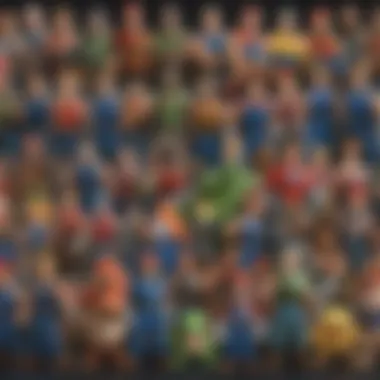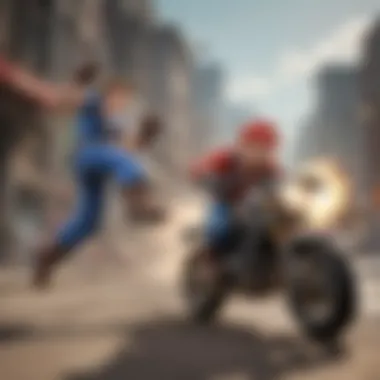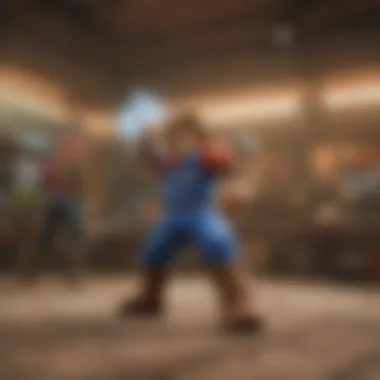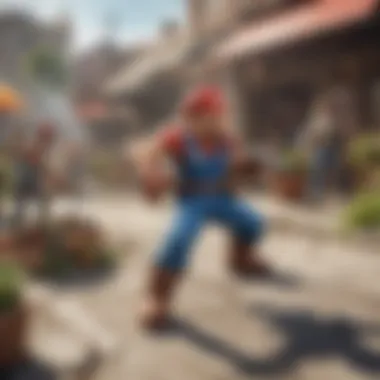Exploring Super Smash Bros. for Nintendo 64: An In-Depth Analysis


Intro
Super Smash Bros. for the Nintendo 64 represents a significant moment in video gaming history. Released in 1999, it stands not only as a game but as a cultural phenomenon. It pioneers the concept of crossover fighting games, allowing characters from various game franchises to battle each other in unique settings. The impact of Super Smash Bros. on multiplayer gaming cannot be overstated. This article will provide an detailed analysis of its mechanics, character roster, and lasting influence, along with a consideration of its competitive scene and how it compares with later entries in the series.
Game Reviews
Overview
Super Smash Bros. merges a variety of gameplay styles for a truly unique experience. Players choose from a roster of beloved Nintendo characters, such as Mario and Link, and engage in combat. The aim is simple: knock opponents off the stage using a combination of attacks, special moves, and items scattered throughout the arena. The blend of familiar faces and dynamic gameplay mechanics create an engaging environment for both casual and serious gamers.
Gameplay
The gameplay of Super Smash Bros. is characterized by its fast pace, accessibility, and depth. It utilizes a four-player system, which enhances social interaction. Players can easily learn the basic controls, yet mastering advanced techniques such as edge-guarding or wave-dashing demands practice and skill. The magnitude of strategies available makes every match feel fresh and exciting.
Storyline
While Super Smash Bros. does not present a traditional storyline, each character brings its own narrative context. Through their beloved game origins, players can feel a connection to the characters. The game is less about a cohesive story and more about the battle between the iconic figures of Nintendo.
Graphics
The graphics of Super Smash Bros. are representative of the Nintendo 64's capabilities. While not visually stunning by today's standards, the character models and environments are recognizable and charming. The simplistic art style allows for excellent playability and does not hinder the action on screen.
Soundtrack
The soundtrack in Super Smash Bros. embraces nostalgia, featuring remixed themes from classic Nintendo titles. Each character’s theme adds depth to the gameplay experience and reinforces the iconic status of the franchise. Sound effects also positively contribute to the immersive experience.
Pros & Cons
Pros:
- Large and diverse character roster
- Fun, chaotic multiplayer matches
- Easy to pick up for new players
- Memorable music and classic sound effects
Cons:
- Limited single-player content
- Outdated graphics compared to modern titles
- Controls can be unresponsive at times
Final Verdict
Super Smash Bros. for Nintendo 64 is an essential title that laid the groundwork for future installments. Its blend of accessibility and depth ensures it is enjoyable for players of all skill levels. The game serves as a testament to the power of nostalgic characters uniting in a battle for fun and rivalry.
Character Spotlights
Preface
Each character in Super Smash Bros. brings unique abilities to the forefront. This section will explore the backgrounds, skills, and legacies of some of the most iconic characters in the game.
Background
Characters like Mario and Link have rich histories in gaming. Their previous titles established their popularity and their transition to this crossover fighting game created an instant appeal. The roster also includes lesser-known characters, which showcases Nintendo’s creative variety.
Abilities & Skills
Every character has distinct moves and abilities. For instance, Mario's versatility allows him to adapt to various strategies, while Pikachu's speed makes it difficult for opponents to predict his movements. These differences drive players to find their favorite characters and master their unique playstyles.
Legacy & Impact
The legacy of these characters extends beyond the game itself. They have become cultural symbols for gaming, representing a generation of gamers. They continue to appear in various Nintendo titles, reinforcing their relevance in the gaming community.
Trivia


Many fans still debate over character balance and tier lists within the competitive scene. Little-known facts about character interactions also add depth to discussions among gamers.
Ending
Super Smash Bros. for Nintendo 64 revolutionized the gaming landscape. The game paved the way for future entries and expanded the multiplayer experience in significant ways. By analyzing its gameplay, characters, and cultural footprint, we can appreciate the enduring legacy of this technical milestone.
Prelude to Super Smash Bros.
This section serves as a pivotal entry point into the world of Super Smash Bros. It is crucial to understand how this title laid the groundwork for future titles in the franchise and influenced multiplayer gaming overall. The introduction provides context, emphasizing the unique characteristics of the game that distinguish it from traditional fighting games. By examining these elements, readers will gain insight into the significance of Super Smash Bros. in gaming history and how it continues to resonate today.
Overview of the Franchise
Super Smash Bros. is a prominent series developed by Nintendo that began with its release on the Nintendo 64 in 1999. It redefined expectations for crossover games by merging beloved characters from various Nintendo franchises into one cohesive gaming experience. This novel concept offered players a unique blend of nostalgia and competitive gameplay. The franchise expanded significantly over the years, introducing new characters, stages, and mechanics while maintaining its core identity.
The games are known for their accessibility. Players can engage from different skill levels, making it a favorite among both casual gamers and competitive players alike. This depth in character roster, with iterations of Mario, Link, and Pikachu, speaks to a broad audience. Each character brings specific abilities and traits, enriching the gameplay dynamics.
Initial Release and Reception
Upon its initial launch in Japan on January 21, 1999, the reception was overwhelming. Critics praised the concept of bringing various characters together in an innovative way. Many appreciated the game's fun mechanics and the multiplayer aspect, which was novel at the time. The game achieved commercial success, selling over five million copies worldwide, cementing its status as a classic.
Players noted the game’s straightforward controls while highlighting the larger strategy involved in mastering character abilities and combinations. The balance between skill and fun drew in diverse gamers, from families playing casually to more serious competitors. Initial reviews showcased a mixture of delight and surprise, prompting questions about potential sequels and the future of such crossover experiences.
"Super Smash Bros. was not just a game; it was a cultural phenomenon that impacted future game design and player expectations."
The franchise continues to evolve, but its roots in this original title impact not just gameplay design but also community engagement and competitive gaming today. Understanding this foundation is essential to appreciating the series' journey through the years.
Development of Super Smash Bros.
The development of Super Smash Bros. is pivotal in understanding how this game became a cornerstone in the realm of multiplayer gaming. This section delves into various aspects that shaped the game, including its design, team collaboration, and the technological limitations faced during its creation. Analyzing these factors offers insight into the game's innovative mechanics and unique appeal.
Concept and Design
The concept for Super Smash Bros. originated from a desire to create a fighting game that differentiated itself from others. Instead of focusing solely on realistic martial arts, it aimed to celebrate Nintendo's iconic characters in a fun, engaging manner. The design process involved blending features from various genres, combining platforming elements with competitive fighting mechanics.
The game uses a unique KO system, where opponents are knocked off the screen rather than depleting health points. This fundamental shift created a more dynamic environment. Each fighter has their own moves, allowing for varied play styles. The game’s accessibility, appealing to casual and competitive gamers alike, was carefully considered during development.
Collaboration of Creators
The success of Super Smash Bros. can be attributed in large part to the collaborative efforts of its creators. Masahiro Sakurai, the director, envisioned a game that would resonate with fans of different Nintendo franchises. He sought input from other Nintendo staff, resulting in a diverse character roster.
This collaboration led to the inclusion of characters like Mario, Link, and Pikachu, which helped bridge the gap between various games and franchises. It was not just the design team that matter; sound designers, graphic artists, and programmers all contributed to creating a cohesive experience. This team effort played a crucial role in ensuring the game was polished and engaging from the outset.
Technological Constraints
Developing Super Smash Bros. for the Nintendo 64 involved significant technological challenges. The console's hardware had limitations that forced developers to make strategic decisions. The graphics needed to be appealing but could not be overly complex, given the memory constraints.
The team had to optimize the game's performance, ensuring it could run smoothly even with multiple characters on screen. Additionally, the game’s physics were designed to be fluid yet responsive, showcasing the talent of the developers. These constraints ultimately pushed the team to innovate, creating features that have since become staples in the franchise.
"Innovation often arises from limitations, turning potential setbacks into creative opportunities."
Gameplay Mechanics
Gameplay mechanics are the backbone of any video game, shaping not only the player's experience but also the overall perception of the title. In Super Smash Bros. for Nintendo 64, these mechanics are particularly significant. They offer a distinctive blend of traditional fighting game elements combined with platforming features. This unique setup lays the groundwork for engaging multiplayer battles and ensures replayability. Understanding these mechanics allows gamers to not only appreciate the depth of the gameplay but also to develop effective strategies while playing.
Core Gameplay Features
Super Smash Bros. introduces several core gameplay features that set it apart from its contemporaries. The game is primarily focused on four-player battles, where each player selects a character from various Nintendo franchises. The objective is simple yet clever: knock opponents off the stage using various attacks. There is no health bar, which brings an innovative twist to how players approach combat. Instead, characters accumulate damage, making them easier to launch off the stage.
Another key feature is the use of a variety of items. These items include weapons and power-ups, such as the Super Star or Home-Run Bat, which add further variety to combat. Players must adapt their strategies based on the items available and their opponents' use of them. This adds layers to the gameplay and fosters unexpected interactions between characters.


Character Abilities and Combos
Each character in Super Smash Bros. has unique abilities that reflect their origins from other Nintendo games. For example, Mario has versatile moves like Fireball and Super Jump Punch, while Link brings a sword and a variety of ranged weapons. Understanding these abilities is crucial for players as they can create combos that exploit the strengths of each character while minimizing their weaknesses.
Combos give players the ability to chain attacks effectively, causing significant damage in quick succession. Mastering these combos elevates a player's skill level. Furthermore, players learn to anticipate their opponents' moves and counter them effectively. This emphasis on skill and timing makes every match dynamic and exciting.
Stages and Environmental Interactions
The stages in Super Smash Bros. play a vital role in shaping gameplay mechanics. Each level is uniquely designed with different terrains and hazards, from the floating platforms of Dream Land to the confined spaces of Hyrule Castle. These environments can create opportunities for skilled players to maneuver their character effectively. However, they also introduce risks and challenges, making spatial awareness critical.
The stages are not just backdrops; they can influence the outcome of a match significantly. Environmental hazards, such as falling objects or lava, require players to adapt their strategies on the fly. In essence, stage selection becomes a tactical decision that can affect game dynamics.
"An understanding of the game mechanics is crucial for both casual and competitive players; it distinguishes the involved from the mere observers."
Character Roster Analysis
Assessing the character roster in Super Smash Bros. for Nintendo 64 is crucial for understanding how it shaped both the game itself and the franchise as a whole. The diverse selection of characters represents iconic figures from various Nintendo franchises. This diversity creates a rich environment for players, enhancing the gameplay experience while increasing the game's appeal. The character choices also speak to a broader strategy of attracting diverse audiences, combining nostalgia with competitive engagement.
Iconic Characters and Their Origins
The roster began with twelve characters. Each character is drawn from different series, like Mario, Zelda, and Metroid. For instance, Mario is the quintessential character, embodying the spirit of Nintendo. Likewise, characters such as Pikachu and Link facilitate a broad appeal to various gaming communities. The origins of these characters are embedded in their respective franchises, making their inclusion meaningful.
- Mario: From the Mario franchise, he is well-known for his platforming adventures.
- Link: The protagonist from the Legend of Zelda series, bringing a sense of adventure and exploration.
- Pikachu: A beloved mascot from Pokémon, appealing especially to younger audiences.
Collectively, these characters contribute to a vibrant atmosphere ripe for competition and personal expression.
Character Balance and Strategy
Character balance remains a pivotal element in Super Smash Bros. Initially, some characters had advantages over others. For example, Mario's versatility balanced his skill set, making him accessible for new players. Conversely, characters like Captain Falcon showed higher skill ceilings. A balanced roster leads to diverse strategies in play, enabling experienced players to innovate.
Considerations for balance include:
- Strengths and Weaknesses: Each character displays unique attributes, demanding strategic choices based on match situations.
- Tier Lists: Informally developed by the community to categorize character effectiveness, these lists help novice players select characters suited for different matches.
Important Note: Balance issues led to community discussions. This dialogue spurred knowledge of techniques, especially in competitive circles.
Player Favorites and Rare Picks
Beyond the core roster, certain characters become favorites or rare picks in gameplay. Characters like Jigglypuff and Ness capture niche but dedicated player bases. These characters often require unique strategies and playstyles different from mainstream icons.
Players may gravitate towards:
- Jigglypuff: Valued for her aerial combat and rest move.
- Ness: Dabbling in unique physics and specials, offering rich gameplay for skilled players.
Exploring less popular characters adds an element of surprise in competitive gaming. Players skilled in using these characters can potentially disrupt predictable strategies employed by opponents. In essence, the variety enables players to express creativity while discovering unexplored gameplay dynamics.
"The character roster acts as both a reflection of Nintendo's legacy and a foundational element of play, shaping interactions and strategies."
Cultural Impact
The cultural impact of Super Smash Bros. for the Nintendo 64 is paramount to understanding not just its role in gaming but its larger influence on entertainment and community. This game bridged gaps between different genres, fostering both casual and competitive play. As players engaged with beloved characters from various franchises, a new social interaction emerged. Super Smash Bros. became more than a simple fighting game; it metamorphosed into a shared experience that resonated across multiple demographics.
Influence on Multiplayer Gaming
Super Smash Bros. introduced mechanics that would shift the landscape of multiplayer gaming. Prior to its release, many fighting games centered around one-on-one battles with fixed characters. In contrast, Smash emphasized chaotic, multiplayer fights, accommodating up to four players simultaneously. This structure fundamentally altered player engagement dynamics. Now, friends could gather, strategize, and challenge each other in vibrant matches that contained an element of unpredictability.
- The user-friendly interface allowed newcomers to pick up the game quickly, reducing barriers for entry.
- Elements such as power-ups and environmental hazards contributed to a less stringent competitive atmosphere.
- Such fresh systems encouraged collaboration and rivalry, promoting social interactions that extended beyond the game itself.
As a result, this framework inspired many future multiplayer titles, establishing a hybrid form of gaming that blended competition with camaraderie.


Community and Competitive Scene
The community surrounding Super Smash Bros. flourished shortly after its release. Players formed local and online groups, which organized tournaments and formed connections. These gatherings allowed enthusiasts to display their skills and develop strategies, leading to a budding competitive scene.
- Websites and forums were created to discuss techniques and share insights.
- Local events expanded into larger tournaments, like those organized by Community Effort Orlando.
This growing competitive landscape demonstrated the game’s versatility. Players began experimenting with its mechanics, emphasizing various character strengths and weaknesses. Tournaments were, and still are, platforms to celebrate skill and creativity. They also fueled a sense of belonging, as players connected over their shared love for the game.
Merchandising and Media Presence
The merchandising and media presence of Super Smash Bros. reflected its cultural significance. Nintendo capitalized on the game's popularity by releasing a plethora of merchandise. T-shirts, figures, and collectibles quickly became staples within gaming culture.
- Collaborations with brands and franchises further extended its reach, as the iconic characters transcended the game.
- A rise in fan art and online discussions showcased its impact on creative expression in the gaming community.
- Its inclusion in various esports events has brought additional visibility.
In essence, Super Smash Bros. positioned itself not only as a game but as a cultural phenomenon that reverberated throughout different aspects of entertainment. This enduring relevance highlights its role in shaping the gaming landscape and fostering an engaged global community.
Technical Aspects
In the landscape of gaming, the technical aspects of a title can significantly impact the overall experience. For Super Smash Bros., the technical elements lay the groundwork for its gameplay and enjoyment. Two core components can be highlighted: graphics and sound design, alongside performance optimization. Each of these elements contributes to how players interact with the game, shaping their perceptions and experiences.
Graphics and Sound Design
The visual and auditory elements of Super Smash Bros. set it apart in the crowded Nintendo 64 library. The graphical design provides a vibrant and dynamic world in which characters battle. Despite the limitations of the Nintendo 64 hardware, the developers utilized clever techniques to create engaging environments. The character models are colorful and distinct, an essential factor given the varied roster that includes iconic faces like Mario and Link.
Sound design also plays a critical role. The music tracks energize players and enhance immersion. Each character has signature sound effects, adding to the uniqueness of gameplay. The selection of music reflects the games from which characters originated, creating a sense of nostalgia and familiarity.
"Super Smash Bros. brought together beloved characters, and its sound and visuals only amplified that experience for players."
Performance Optimization
Performance is a vital aspect of any multiplayer competitive game. Throughout development, the optimization of Super Smash Bros. became essential for smooth gameplay, especially during intense moments of combat. The team sought to ensure that the game's frame rates remained stable, even amidst chaotic battles involving multiple fighters on screen. Minimizing lag was paramount to provide an enjoyable experience for players, as any stuttering could significantly hinder performance.
Player responsiveness remained a focus. The controls needed to be intuitive and reactive, allowing players to execute combos and evade attacks fluidly. This level of optimization contributed to the game's lasting appeal, proving crucial for players who desired a competitive and seamless gaming experience.
In summary, the technical aspects of Super Smash Bros. are essential for its lasting legacy. The harmonious blend of graphics, sound design, and performance optimization created a title that not only stands out technically but also enhances the overall enjoyment for players.
Legacy and Evolution
The legacy of Super Smash Bros. on the Nintendo 64 extends far beyond its initial release. This game marks a significant point in the history of multiplayer gaming and is an integral pillar of Nintendo's gaming identity. The revolutionary concept of bringing together iconic characters from diverse franchises not only attracted fans across different gaming demographics but also shifted the paradigm of multiplayer interactions at the time. With its engaging gameplay and community-driven spirit, Super Smash Bros. laid the groundwork for future titles in its series and influenced game design and community dynamics in broader gaming landscapes.
Reception of Subsequent Titles
The release of Super Smash Bros. paved the way for its sequels to thrive, each one building upon the foundation established by the original. The transition to the Nintendo GameCube with Super Smash Bros. Melee is particularly notable. Melee was received with overwhelming enthusiasm and is often regarded as a hallmark in competitive gaming. It embraced the beloved mechanics from the N64 version while introducing improved graphics and refined mechanics. This titles elevated competitive play to new heights, establishing a strong community and nurturing an enduring competitive scene.
Moreover, Super Smash Bros. Brawl, released on the Wii, introduced new gameplay elements such as the inclusion of online play, which reflected the growing demand for connected experiences. Each subsequent title continued to refine and evolve core gameplay features, contributing to a rich lineage that maintains the community’s interest and expands the game's player base.
Enduring Popularity in Gaming Communities
The enduring popularity of Super Smash Bros. within gaming communities is remarkable. This game fosters not only competition but also camaraderie among players. Tournaments have sprung up globally, driven by the need for players to showcase their skills and engage with the larger community. The cultural significance is underlined through various events and forums dedicated to the series. Online platforms such as Reddit and Facebook host bustling discussions among fans, where strategies are shared, memes are created, and nostalgia is celebrated.
Furthermore, the ability to mod the game allows players to keep experiences fresh, enabling a continuous renewal of interest. Players identify with their favorite characters and form lasting friendships as they gather in competitive or casual settings. Super Smash Bros. thus stands as a continuously evolving fixture in gaming, nurturing a loyal fanbase who keep the legacy alive with each new generation of players.
Ending
In examining the legacy of Super Smash Bros. for Nintendo 64, it becomes clear that its impact reaches far beyond mere entertainment. The game established foundational elements crucial to the environment of competitive gaming. Here, the blend of character diversity and dynamic gameplay fostered a unique atmosphere that captivated both casual and serious players alike.
Reflections on Super Smash Bros. N64
Reflection on this title recalls a simpler time in gaming history when multiplayer interactions were not as commonplace as they are today. The mechanics introduced in Super Smash Bros. not only influenced future games, but also shaped community gatherings and local tournaments. The game's ability to allow friends to battle using iconic characters from beloved franchises helped establish a tight-knit culture among players.
Moreover, each character had distinctive abilities, creating a landscape where strategic choices in gameplay emerged. This encouraged players to experiment and master different characters, leading to a rich tapestry of play styles and experiences. The social and competitive aspects of the game can still be felt within the Nintendo community and competitive gaming arenas.
Future of the Franchise
Looking towards the future, the franchise is poised to continue its evolution while staying true to its roots. Nintendo’s ability to innovate while respecting the original's formula is crucial. Future titles may incorporate new technological advancements, such as improved online play and expanded character rosters.
The growing esports scene provides further opportunities for Super Smash Bros. to cement its place in competitive gaming. As more players enter the arena, the franchise may evolve to include diverse modes and community-driven content.



